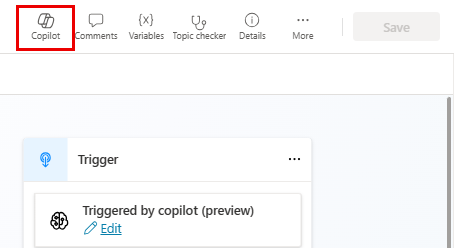Note
Access to this page requires authorization. You can try signing in or changing directories.
Access to this page requires authorization. You can try changing directories.
Instead of manually creating and editing topics, Copilot Studio lets you use Copilot to create and iterate on topics, by describing what you want and having AI build it for you.
AI understands what you want to do, then automatically creates a topic with different node types and conversational responses.
The AI-based agent authoring overview shows how this capability works. You can also use agent authoring with generative answers to boost conversations.
Note
This capability might be subject to usage limits or capacity throttling.
Prerequisites
Review the FAQ for Copilot and learn more about Azure OpenAI
Review the list of supported languages
Use Copilot to create a topic in Copilot Studio
Go to the Topics page for your agent.
Select Add a topic > Create from description with Copilot.
In Create from description with Copilot, enter a name for your topic.
Describe the topic you want to create in simple, plain English. You can include questions you want the agent to ask, messages it should show, and details of the desired behavior.
Tip
To get started, you can select any of the examples. Select View more examples to generate new suggestions.
Select Create.
The new topic appears. The topic includes trigger phrases, and one or more nodes, based on your description.
Use Copilot to edit a topic in Copilot Studio
You can make changes to any topic using the power of natural language understanding (NLU).
Go to the Topics page for your agent, and open the topic you want to modify.
Select Copilot on the toolbar.

In Edit with Copilot, describe what you'd like to change. Use simple, plain English to direct the AI, like in these examples:
- add a question to ask the user for their date of birth
- add two message variations to all questions in the topic
- summarize the information collected from the user in an Adaptive Card
Tip
When you describe a task for your agent, there's no need to mention design elements. For example, if your description includes ask the user their full name, Copilot automatically generates (or updates) a Question node.
Select Update.
You can continue to edit your topic or describe more changes.
If you don't like the changes, select the Undo icon
 and select Undo to go back one action or select Undo to last save to go back to the last save point.
and select Undo to go back one action or select Undo to last save to go back to the last save point.
Tip
To give feedback on the AI, select the "thumbs up" or "thumbs down" icon at the bottom of the Edit with Copilot panel.
Select the thumbs down icon and add detailed feedback. We use this feedback to improve the quality of the AI.
What's supported
Copilot can create Message, Question, and Condition nodes when building and iterating on topics in Copilot Studio. Other node types aren't currently supported.
Nodes generated by Copilot in Copilot Studio have the following limitations:
Copilot understands the required properties on Message, Question, and Condition nodes, such as text to prompt the user or the appropriate output variables. However, Copilot doesn't understand advanced properties of these nodes, such as the reprompt and interruption settings for a Question node. You can still manually edit these properties.
Condition nodes that branch a topic from a multiple choice question might show errors in the generated conditions. You can troubleshoot these errors manually.